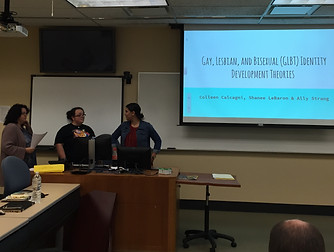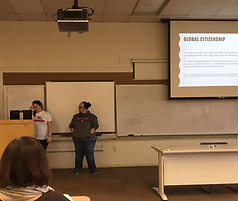Ally Baldwin, M.Ed.
Social Justice & Inclusion
Student affairs professionals are educators. As educators, our primary goal is to create equitable learning environments for our students. In fact, ACPA & NASPA suggest that “the construct of equity [is] more than a goal, but a precondition of a larger good” (ACPA & NASPA, 2015, pp. 5). When we consider social justice as a process rather than a destination, it becomes a helpful lens to inform our professional practice. For me, this means that I specifically strive to: identify systems of socialization that influence one’s multiple identities and sociopolitical perspectives and how they impact one’s lived experiences, engage in critical reflection in order to identify one’s own prejudices and biases, and identify systemic barriers to social justice and inclusion and assess one’s own department’s role in addressing such barriers (ACPA & NASPA, 2015, pp. 30).
Social justice has always been important to me. The first day of my Multicultural Issues in Student Affairs class, I (proudly) announced that I didn’t think I had any negative bias against specific groups. The faculty member reacted with a bemused smile, and offered me a chance to reconsider. When I didn’t, we moved on with class. This brief exchange sat with me all day. My peers moved on to discussing other things and all I could think about was: “Obviously I would know if I had unconscious bias!” I must have repeated it a hundred times before it sunk in. Just like looking for ice cream in the microwave and finding it in the freezer, this was my epiphany. While being “more authentic” is an arguably cliche goal, I set my sights on pursuing this kind of honesty in my professional career. For me, it’s not just about owning my biases and identities. It’s also about learning from and supporting the people I interact with: student or colleague.
The Socialization of Bias
I felt dissonant after realizing that I had unconscious biases influencing me. I doubted my goodness as a person. However, Hardiman and Keehn describe that “the awareness of overt racism is less prevalent…racism has not disappeared but has become more hidden” (Hardiman & Keehn in Wijeyesinghe & Jackson III, 2012, pp. 132). This was an idea that I found helpful because it helped me determine why I had not realized my biases existed sooner. I was also glad that it did not excuse my actions. Instead, I addressed this issue by engaging in reflection.
According to Chesler “when people do not explore the historic or contemporary bases on which equality exists, it is hard for them to act with fairness, much less to serve as effective advocates for racial justice (Chesler, 2005, pp. 48). As I reflected, I considered the various influences on my development and applied my knowledge of Haro's Cycle of Socialization (Haro in Adams, Blumenfield, Castañada, Hackman, Peters & Zúñiga, 2013, pp. 46) to clarify where my biases originated. While many originated early (First Socialization), a majority came from institutional and cultural socialization and enforcements. My social group membership analysis paper addresses the ways I challenged myself to take ownership of these biases and challenge their continued enforcement. I began to reflect on each meeting I had with students who were interested in completing the cooperative education course for the upcoming semester. Over time, I saw themes emerge that gave me an opportunity to consider the point at which my knowledge should turn into action
Reflection & Theory
Although acknowledging the existence of my biases was important, I needed to act more on this new information. For class, I completed some implicit attitude tests as part of one of our assignments (Project Implicit, 2011). After I reviewed my results, I came to the (astoundingly obvious) realization that my identities do not make me an inherently more or less multiculturally competent person. I can be biased against a certain identity group regardless of my membership within or outside of that group. I was increasingly realizing that my practice needed to be more informed by theory.
To practice incorporating specific theoretical perspectives, my colleagues and I presented on the topic of LGBT+ Identity Development. By using Cass (1979) and D'Augelli's (1994) theories, which focus on LGBT+ identity development and relationships with peers/family/community members, I more objectively understood how I could be more intentional in interactions with LGBT+ students. The theories also gave me an opportunity to separate my professional practice from my informal theories as a member of the LGBT+ community. This has a powerful impact on my work with students, since the campus climate is known to have an impact on vocational identity development. As a career services professional, I have an increased interest in creating a welcoming environment for that (and other) reasons (Tomlinson & Fassinger, 2003).
Practice
Pope, Reynolds & Mueller assert that “multicultural competence is not about getting to a destination” (Pope, Reynolds & Mueller, 2004, pp. 26). Although I want to address my biases to create more equitable learning environments and I wish I could create a magically inclusive space, I also recognize that I am not living in unicorn-land. There are very real forces that prevent higher education from embracing complete equality and inclusivity. Instead of resigning myself to that reality, though, I'd like to continuously challenge myself to consider multicultural student identities in hopes that they won't always be pervasive. I have a friend whose words describe my approach to this work very well. As student affairs professionals, sometimes this will be the only realistic course of action that we can take:
"Seek to understand that we all have varying levels of exposure to difference and desire to understand. I may not like it, but I have no power over it."
One way that I can practice putting this into action this in my work is happening right now. Over the course of the past several months, I collaboratively conducted research with a few other office staff to determine what kinds of barriers prevent students from using our office services and resources. I observed that there were varying levels of privilege for different staff members. The differences weren't evident in the final questions we brainstormed. As the data is compiled, however, we may find that multicultural students are not as comfortable and satisfied as we thought they were and that our privilege may be masking some of the reality. If that is the case, it could elicit natural reactions from the team. Instead of denying that possibility, I can use it as an opportunity to grow and to encourage growth in my colleagues.


References:
ACPA & NASPA (2015). Professional Competency Areas for Student Affairs Educators. Washington, D.C.: Authors.
Cass, V.C. (1979). Homosexual identity formation: A theoretical model. Journal of Homosexuality, 4. 219-235.
Chesler, M. A. (2005). An organizational framework for analyzing racism in educational organizations. Challenging racism in higher education. New Orleans, LA: Rowman & Littlefield Publishers, Inc.
D'Augelli, A.R. (1994). Identity development and sexual orientation: Toward a model of lesbian, gay, and bisexual identity development. In E.J. Trickett, R.J. Watts & D. Birman (Eds.) Human diversity: Perspectives on people in context (pp. 312-333). San Francisco: Jossey-Bass
Hardiman, R. & Keehn, M. (2012). White identity development revisited: Listening to white students. In C.L. Wijeyesinghe & B.W.
Jackson III (Eds.) New perspectives on racial identity development: Integrating emerging frameworks. (2nd ed.; pp. 121-135). New York: New York University Press.
Harro, B. (2013). The cycle of socialization. In M. Adams, W. J. Blumenfeld, C.R. Castańeda, H.W. Hackman, M.L. Peters & X. Zúñiga (Eds.) Readings for diversity and social justice. (3rd ed.; pp. 45-56). New York: Routledge.
Pope, R.L., Reynolds, A.L. & Mueller, J.A. (2004). Multicultural competence in student affairs. San Francisco: Jossey-Bass.
Tomlinson, M.J. & Fassinger, R.E. (2003). Career development, lesbian identity, development, and campus climate among lesbian college students. Journal of College Student Development, 44. 845-860.



